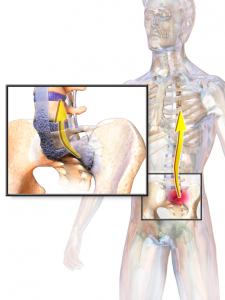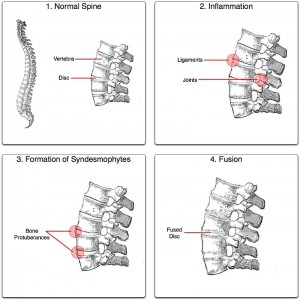 Anytime you see a medical condition that ends in itis, you are looking at a swelling, or inflammatory issue. Ankylosing spondylitis is grouped with a host of other arthritic conditions (psoriatic arthritis, ulcerative colitis, reactive arthritis) that are known as spondyloarthropathies. Even though spondylo refers specifically to the spine (it means vertebrae in Greek) ankylosing spondylitis can occur in a number of joints throughout the body.
Anytime you see a medical condition that ends in itis, you are looking at a swelling, or inflammatory issue. Ankylosing spondylitis is grouped with a host of other arthritic conditions (psoriatic arthritis, ulcerative colitis, reactive arthritis) that are known as spondyloarthropathies. Even though spondylo refers specifically to the spine (it means vertebrae in Greek) ankylosing spondylitis can occur in a number of joints throughout the body.
There are many forms of connective tissue throughout the body. Muscle, ligament and tendon are all connective tissues. Another connective tissue that lives between tendon or ligament and bone is called the enthesis.
When it comes to ankylosing spondylitis, it is usually an inflammation of the enthesis that is the source of the problem. While ankylosing spondylitis can occur in joints throughout the body it is located most often in the spine and very often at L5/S1 where the lower spine meets the sacrum.
Ankylos is the Greek for fusion. So ankylosing spondylitis refers to the fusion of the spine due to the swelling of the enthesis. When the enthesis swells during a bad episode and then heals, scar tissue is often left in its wake. Over long periods of time that scar tissue can calcify forming new bone.
This type of calcification can lead to more limited movement within the spine and ultimately, in really bad cases, enough scar tissue can form leading to the fusion of numerous joints together. Lack of movement in any part of the spine can have profound implications for the rest of the body as well.
All joints are meant to be reciprocal so that movement in one leads to movement in another but fused joints interrupt this chain of movement and can lead to greater pain, and can also affect posture negatively, throwing off the ability for the spine to align correctly.
Ankylosing spondylitis can also affect the breath as well if the middle of the spine and rib cage are involved. The cartilage between the ribs is susceptible to this same swelling of the enthesis and the same process of swelling and healing with the formation of scar tissue following healing can lead to decreased ranger of motion in the rib cage which in turn limits our capacity for breath.
As with so many aspects of our lives, there is a use it or lose it aspect to ankylosing spondylitis. While there isn’t a known cure, movement and exercise will serve the issue way more effectively than rest. In fact, rest will often lead to greater stiffness and discomfort.
Since I live in the world of improving posture it is obvious that I think better posture will help the body combat the progression of ankylosing spondylitis. And it might seem weird to say but if you are going to end up with a fused spine it would serve you well if that spine were correctly aligned.
When it comes to spinal issues I am a big fan of muscular support. Problems like ankylosing spondylitis, or spondylosis etc., can be supported with balanced muscle tone. If the muscles that surround the joints are strong and supple, the spine will be supported in a way that can minimize the deterioration of the spine that is often associated with these issues.
***

